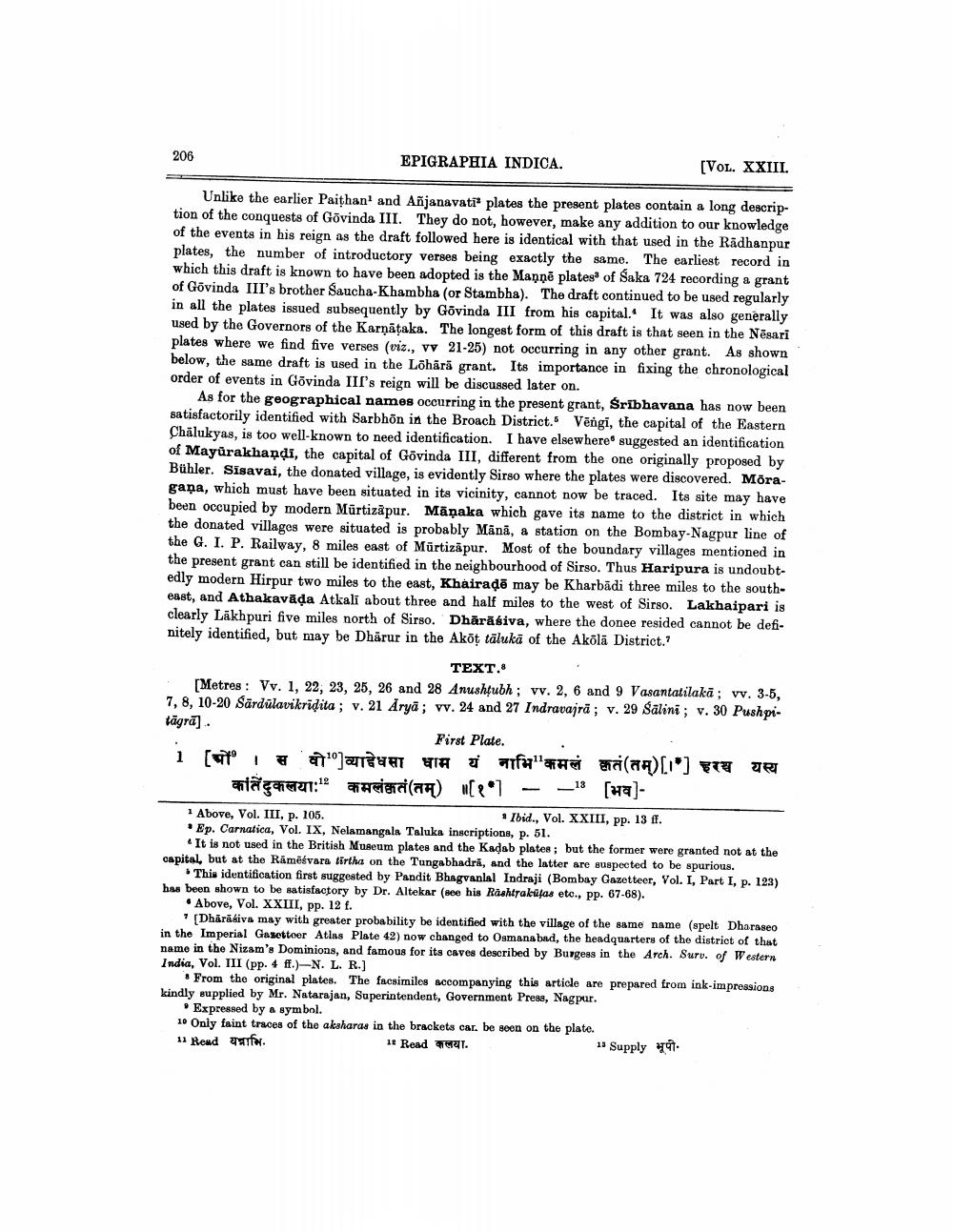________________
206
EPIGRAPHIA INDICA.
(VOL. XXIIL
Unlike the earlier Paithan and Añjanavati plates the present plates contain a long description of the conquests of Govinda III. They do not, however, make any addition to our knowledge of the events in his reign as the draft followed here is identical with that used in the Rādhanpur plates, the number of introductory verses being exactly the same. The earliest record in which this draft is known to have been adopted is the Maņņē plates of Saka 724 recording a grant of Govinda III's brother Saucha-Khambha (or Stambha). The draft continued to be used regularly in all the plates issued subsequently by Govinda III from his capital. It was also generally used by the Governors of the Karnataka. The longest form of this draft is that seen in the Nēsari plates where we find five verses (viz., vv 21-25) not occurring in any other grant. As shown below, the same draft is used in the Lõhärä grant. Its importance in fixing the chronological order of events in Govinda III's reign will be discussed later on.
As for the geographical names occurring in the present grant, Śribhavana has now been satisfactorily identified with Sarbhon in the Broach District. Vēngi, the capital of the Eastern Chalukyas, is too well-known to need identification. I have elsewhere suggested an identification of Mayurakhandi, the capital of Govinda III, different from the one originally proposed by Bühler. Sīsavai, the donated village, is evidently Sirso where the plates were discovered. Moragana, which must have been situated in its vicinity, cannot now be traced. Its site may have been occupied by modern Mürtizāpur. Māņaka which gave its name to the district in which the donated villages were situated is probably Mānā, a station on the Bombay-Nagpur line of the G. I. P. Railway, 8 miles east of Mūrtizāpur. Most of the boundary villages mentioned in the present grant can still be identified in the neighbourhood of Sirso. Thus Haripura is undoubtedly modern Hirpur two miles to the east, Khairadē may be Kharbādi three miles to the southeast, and Athakavāda Atkali about three and half miles to the west of Sirso. Lakhaipari is clearly Lakhpuri five miles north of Sirso. Dhārāśiva, where the donee resided cannot be definitely identified, but may be Dharur in the Akõt tälukā of the Akola District.?
TEXT. [Metres: Vv. 1, 22, 23, 25, 26 and 28 Anushtubh ; v. 2, 6 and 9 Vasantatilakā; vv. 3-5, 7, 8, 10-20 Sārdūlavikridita ; v. 21 Aryā; vv. 24 and 27 Indravajrā; v. 29 Salini; v. 30 Pushpitāgrā] .
First Plate. 1 (to I "ZEYT VIA Jaf#"*H3 () [1] FIT JR
açant: Fried(a) [87 - - 13 [H2)1 Above, Vol. III, p. 106.
Ibid., Vol. XXIII, pp. 13 ff. • Ep. Carnatica, Vol. IX, Nelamangala Taluka inscriptions, p. 51.
It is not used in the British Museum plates and the Kadab plates ; but the former were granted not at the capital, but at the Rāmēśvara tirtha on the Tungabhadra, and the latter are suspected to be spurious.
. This identification first suggested by Pandit Bhagvanlal Indraji (Bombay Gazetteer, Vol. I, Part I, p. 123) has been shown to be satisfactory by Dr. Altekar (see his Rashtrakifas etc., pp. 67-68).
• Above, Vol. XXIII, pp. 12 f.
[Dhärāsiva may with greater probability be identified with the village of the same name (spelt Dharaseo in the Imperial Gazetteer Atlas Plate 42) now changed to Osmanabad, the headquarters of the district of that name in the Nizam's Dominions, and famous for its caves described by Burgess in the Arch. Surv. of Western India, Vol. III (pp. 4 ff.)-N. L. R.]
From the original plates. The facsimiles accompanying this article are prepared from ink-impressions kindly supplied by Mr. Natarajan, Superintendent, Government Press, Nagpur.
. Expressed by a symbol. 1. Only faint traces of the akaharas in the brackets car. be seen on the plate. 11 Read for. 11 Read T.
13 Supply 4




